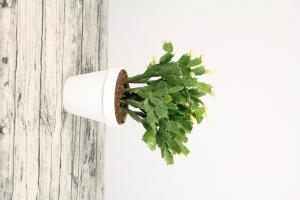Introduction
Palm trees are a popular choice for planting in outdoor spaces. They come in various sizes and are relatively easy to care for, making them ideal for homeowners with busy schedules. However, like any other plant, they require regular pruning to maintain their health and appearance. In this article, we will guide you through the steps on how to prune a palm tree in a planter.
Tools Required
Before you begin pruning your palm tree, make sure you have the right tools on hand. You will need pruning shears, loppers, a saw, gloves, and safety glasses. Pruning shears are useful for trimming small branches and leaves, while loppers can handle larger branches up to 2 inches in diameter. A saw is necessary for cutting thicker branches.
Identify Dead and Dying Fronds
The first step in pruning a palm tree is to identify the dead and dying fronds. These are the dead, partially dead, or yellowing leaves that the tree sheds naturally. Removing these fronds will not only enhance the appearance of the tree but also help to prevent pests and diseases from attacking the healthy parts of the palm.
Trimming the Fronds
Once you have identified the dead and dying fronds, use your pruning shears or loppers to trim them off. Start at the bottom of the frond and work your way up towards the trunk. Make sure to cut the frond as close to the stem as possible to avoid leaving a stub, as these can invite pests and diseases. Be careful not to cut any healthy fronds in the process.
Pruning the Trunk
If your palm tree has a trunk, you may need to prune it as well. Pruning the trunk involves removing any dried or dead parts of the bark. You can do this with a saw, but be careful not to cut too deep into the trunk, as this can cause permanent damage to the tree. Only remove the parts of the bark that are visibly dead, leaving the healthy bark intact.
Special Considerations
When pruning palm trees, there are some special considerations to keep in mind. For example, make sure to avoid pruning the top of the tree, known as the terminal bud. This is the point from which new fronds emerge, and cutting it off can stunt the growth of the tree or even kill it. Additionally, be mindful of any wildlife that might be living in the tree, such as birds or squirrels. Try to avoid disturbing their habitats when pruning.
Conclusion
Pruning a palm tree is an essential part of its care, as it helps to maintain its health and appearance. By following these simple steps, you can ensure that your palm tree remains healthy and beautiful for years to come. Remember to have the right tools, identify the dead and dying fronds, trim them off, prune the trunk if necessary, and keep any special considerations in mind. Happy pruning!

 how many times do yo...
how many times do yo... how many planted tre...
how many planted tre... how many pine trees ...
how many pine trees ... how many pecan trees...
how many pecan trees... how many plants comp...
how many plants comp... how many plants can ...
how many plants can ... how many plants and ...
how many plants and ... how many pepper plan...
how many pepper plan...
































